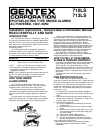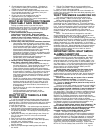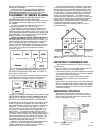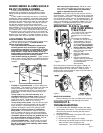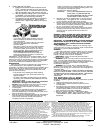
2. Check bedroom doors before opening. If the door is
hot or smoke is leaking in around the edges-DO NOT
OPEN-use the alternate escape route.
3. If there is smoke in the escape route-keep close to the
floor and take short breaths. If possible, cover your
nose and mouth with a wet cloth.
4. Do not use your own telephone-call the Fire
Department from your neighbor's house.
5. Once out, do not re-enter your house, but proceed to
your prearranged meeting place.
WHAT ELSE YOU CAN DO TO MAKE
YOUR FAMILY SAFE FROM FIRES
Putting up smoke alarms is just the first step in
protecting your family from fires. You also must reduce the
chances that fires will start in your home and increase your
chances of safely escaping if one does start. To have an
effective fire safety program:
a. Install smoke alarms properly following the
instructions in this manual. Keep your smoke
alarms clean. Test your alarm weekly and repair or
replace it when it no longer functions. As with any
electronic product, alarms have a limited life, and alarms
that don't work cannot protect you.
b. Follow safety rules and prevent hazardous situations:
· Use smoking materials properly; never smoke in bed.
· Keep matches and cigarette lighters away from children.
· Store flammable materials in proper containers and
never use them near open flames or sparks.
· Keep electrical appliances and cords in good working
order and do not overload electrical circuits.
· Keep stoves, fireplaces, chimneys, and barbecue grills
grease-free and make sure they are properly installed
away from combustible materials.
· Keep portable heaters and open flames such as
candles away from combustible materials.
· Do not allow rubbish to accumulate.
c. Develop a family escape plan and practice it with your
entire family, especially small children.
· Draw a floor plan of your home and find two ways to
exit from each room. There should be one way to get
out of each bedroom without opening the door.
· Teach children what the smoke alarm signal means,
and that they must be prepared to leave the residence
by themselves if necessary. Show them how to check
to see if doors are hot before opening them, how to
stay close to the floor and crawl if necessary, and how
to use the alternate exit if the door is hot and should
not be opened.
· Decide on a meeting place a safe distance from your
house and make sure that all your children understand
that they should go and wait for you if there is a fire.
· Hold fire drills at least every 6 months to make sure
that everyone, even small children, know what to do
to escape safely.
· Know where to go to call the fire department from out
side your residence.
· Provide emergency equipment such as fire
extinguishers and teach your family to use this
equipment properly.
WHAT TO DO IF THERE IS A FIRE
IN YOUR HOME
If you have prepared family escape plans and practiced
them with your family, you have increased their chances of
escaping safely. Review the following rules with your children
when you have fire drills so everyone will remember them
in a real fire emergency:
a. Don't panic; stay calm. Your safe escape may depend on
thinking clearly and remembering what you have practiced.
b. Get out of the house following a planned escape route
as quickly as possible. Do not stop to collect anything or
to get dressed.
c. Open doors carefully only after feeling to see if they are
hot. Do not open a door if it is hot; use an alternate
escape route.
d. Stay close to the floor; smoke and hot gases rise.
e. Cover your nose and mouth with a cloth, wet if possible,
and take short, shallow breaths.
f. Keep doors and windows closed unless you open
them to escape.
g. Meet at your prearranged meeting place after leaving
the house.
h. Call the Fire Department as soon as possible from
outside your house. Give the address and your name.
i. Never re-enter a burning building.
Contact your local Fire Department for more information on
making your home safer from fires and about preparing your
family's escape plans.
WHAT THIS SMOKE ALARM CAN DO
This alarm is designed to sense smoke entering its
sensing chamber. It does not sense gas, heat, or flames.
When properly located, installed, and maintained, this
smoke alarm is designed to provide early warning of
developing fires at a reasonable cost. This alarm monitors
the air and, when it senses smoke, activates its built-in alarm
horn. It can provide precious time for you and your family to
escape from your residence before a fire spreads. Such an
early warning, however, is possible only if the alarm is
located, installed, and maintained as specified in this User's
Manual.
NOTE: This smoke alarm is designed for use within
single residential living units only; that is, it should be used
inside a single-family home or one apartment of a
multi-family building. In a multi-family building, the alarm may
not provide early warning for residents if it is placed outside of
the residential units, such as on outside porches, in corridors,
lobbies, basements, or in other apartments. In multi-family
buildings, each residential unit should have alarms to alert the
residents of that unit. Alarms designed to be interconnected
should be interconnected within one family residence only;
otherwise, nuisance alarms will occur when an alarm in
another living unit is tested.
IMPORTANT NOTE: WHAT SMOKE
ALARMS CANNOT DO
Smoke alarms will not work without power. Battery-
operated alarms will not work without batteries, with dead
batteries, or if the batteries are not installed properly. AC
powered alarms will not work if their AC power supply is cut
off by an electrical fire, an open fuse or circuit breaker, or for
any other reason. If you are concerned about the reliability of
either the batteries or your AC power supply for any of the
above reasons, you should install both battery and AC
powered alarms for maximum safety.
Smoke alarms may not sense fire that starts where
smoke cannot reach the alarms such as in chimneys, in
walls, on roofs, or on the other side of closed doors. If
bedroom doors are usually closed at night, alarms should be
placed in each bedroom as well as in the common hallway
between them.
Smoke alarms also may not sense a fire on another
level of a residence or building. For example, a
second-floor alarm may not sense a first-floor or basement
fire. Therefore, alarms should be placed on every level of
a residence or building.
The horn in your alarm meets or exceeds current audibility
requirements of Underwriters Laboratories. However, if the
alarm is located outside a bedroom, it may not wake up a
sound sleeper, especially if the bedroom door is closed or
only partly open. If the alarm is located on a different level of
the residence than the bedroom, it is even less likely to wake
up people sleeping in the bedroom. In such cases, the
National Fire Protection Association recommends that the
alarms be interconnected so that an alarm on any level of the
residence will sound an alarm loud enough to awaken
sleepers in closed bedrooms. This can be done by installing a
fire-detection system, by connecting alarms together, or by
using radio frequency transmitters and receivers.
All types of smoke alarm sensors have limitations. No
type of smoke alarm can sense every kind of fire every
time. In general, alarms may not always warn you about
fires caused by violent explosions, escaping gas,
improper storage of flammable materials, or arson.
NOTE: This alarm is not designed to replace
special-purpose fire detection and alarm systems necessary
to protect persons and property in non-residential buildings
such as warehouses, or other large industrial or commercial
buildings. It alone is not a suitable substitute for complete
fire-detection systems designed to protect individuals in hotels
and motels, dormitories, hospitals, or other health and
supervisory care and retirement institutions. Please refer to
NFPA 101,The Life Safety Code, and NFPA 72 for smoke
Pg. 7-2



